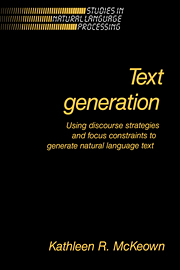Book contents
- Frontmatter
- Contents
- Preface
- 1 Introduction
- 2 Discourse Structure
- 3 Focusing in discourse
- 4 TEXT system implementation
- 5 Discourse history
- 6 Related generation research
- 7 Summary and conclusions
- Appendix A Sample output of the TEXT system
- Appendix B Introduction to Working
- Appendix C Resources used
- Appendix D Predicate Semantics
- Bibliography
- Index
2 - Discourse Structure
Published online by Cambridge University Press: 23 December 2009
- Frontmatter
- Contents
- Preface
- 1 Introduction
- 2 Discourse Structure
- 3 Focusing in discourse
- 4 TEXT system implementation
- 5 Discourse history
- 6 Related generation research
- 7 Summary and conclusions
- Appendix A Sample output of the TEXT system
- Appendix B Introduction to Working
- Appendix C Resources used
- Appendix D Predicate Semantics
- Bibliography
- Index
Summary
The approach I have taken towards text generation is based on two fundamental hypotheses about the production of text: 1) that how information is stored in memory and how a person describes that information need not be the same and 2) that people have preconceived notions about the ways in which descriptions can be achieved.
I assume that information is not described in exactly the same way it is organized in memory. Rather, such descriptions reflect one or more principles of text organization. It is not uncommon for a person to repeat himself and talk about the same thing on different occasions. Rarely, however, will he repeat himself exactly. He may describe aspects of the subject which he omitted on first telling or he may, on the other hand, describe things from a different perspective, giving the text a new emphasis. Chafe (79) has performed a series of experiments which he claims support the notion that the speaker decides as he is talking what material should go into a sentence. These experiments show that the distribution of semantic constituents among sentences often varies significantly from one version of a narrative to another.
The second hypothesis central to this research is that people have preconceived ideas about the means with which particular communicative tasks can be achieved as well as the ways in which these means can be integrated to form a text. In other words, people generally follow standard patterns of discourse structure. For example, they commonly begin a narrative by describing the setting (the scene, the characters, or the time-frame).
- Type
- Chapter
- Information
- Text Generation , pp. 19 - 54Publisher: Cambridge University PressPrint publication year: 1985

